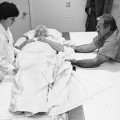After completing the chapter, the reader will be able to perform the following: • Provide definitions of life and death. • Differentiate between the patient’s and the imaging professional’s role in death and dying. • Identify the physical and ethical differences between active and passive suicide. • State a perceived need for euthanasia. • Develop arguments for and against the right to die. • Define the meaning of quality of life and explain what affects it. • List reasons for ethics committees. • Cite the basis for the patient’s right to forgo life-sustaining treatment. • Define and understand differences between a persistent vegetative state and a minimally conscious state. • Define how death is determined. • Define life-sustaining treatment and its exclusions. • Explain the difference between living wills and durable powers of attorney. • Identify the limitations of living wills. • Define the advantages of durable powers of attorney. • Compare the ways in which powers of attorney influence the decision-making process of ancillary people such as physicians, ministers, and specified family members and friends. • Identify the differences between persons in a persistent vegetative state and those in a minimally conscious state. • Explain the difference between competency and decisional capacity. • Contrast the treatment of persons who have never been competent and competent persons who have become incompetent. Traditional religious and secular beliefs celebrate the uniqueness of life, but when life begins and the way it ends remain points of contention. The imaging professional should consider the following aspects of life when making determinations in ethical dilemmas1: • Life is the foundation of all other values of a patient. • Life is the foundation of a patient’s rights. • The preservation and maintenance of a good quality of life are the goals of the patient entering the health care environment. • A patient is motivated to enter the health care environment when capabilities and potentialities are radically affected. If a patient can regain these capabilities and potentialities, quality of life is greatly improved. • A patient, except in the most extreme circumstances, has no rational desire greater than the desire for life. Nevertheless, in extreme circumstances a desire for death may not be irrational. The ethics of the taking of human life becomes a consideration in a number of patient care situations, and imaging professionals may have to address this issue during their interactions with patients. Respect for the sanctity of human life entails an obligation not to infringe on an individual’s decisions regarding life and an obligation not to take human life.2 Nevertheless, questions about the sanctity of life arise in situations of assisted suicide and when patients are suffering from life-threatening disease or illness. Several arguments may be made against suicide (Box 6-1). Some find it unacceptable for religious reasons—God has lent life to the individual, and therefore that life is not the individual’s to end. Others believe that human life is the greatest of goods and consider it precious. However, what if the patient has tremendous pain and therapy has caused such nausea and weakness that the patient cannot move from bed? Is life “good” at this level of pain and loss of dignity? Harm to the community is another argument against suicide. If one suicide leads to another (as has been observed with teenage suicides), does this not harm the community? A further argument against suicide is the harm it inflicts on family and friends. Suicide denies them time with their loved ones to plan, share, make amends, and say good-bye. Many imaging professionals have encountered patients who have no hope of becoming well and whose pain can no longer be controlled with drugs. Their lives are full of pain and suffering, and their desire to end their lives may be reasonable. If these patients discontinue treatment, they will suffer but die sooner. They could also overdose and end their suffering quickly. Whether the suicide is active or passive, imaging professionals should be careful not to make judgments. What should be the response of an imaging professional asked to interact with a patient determined to commit suicide (Box 6-2)? In what way should an imaging professional respond when approached by a patient who wishes to end life either actively or passively? These may be rare situations for imaging specialists, but they must be considered because of imaging professionals’ changing interactions with patients and their families. Imaging professionals must recognize that each case is different. They may be required to participate in procedures involving patients who have elected to end nourishment and hydration. The imaging professional must remember that it is the value system of the patient that is important in such situations, not the value system of the imaging professional. Suicide is taken one step further when another person becomes involved. Euthanasia is the act of painlessly putting to death a person suffering from an incurable and painful disease or condition. Physician participation in euthanasia, or assisted suicide, has stirred great controversy recently (Box 6-3). The legal issues surrounding physician-assisted suicide are discussed in the legal section of this chapter.
Death and Dying
ETHICAL ISSUES
VALUE OF LIFE
SANCTITY OF HUMAN LIFE
SUICIDE
IMAGING PROFESSIONALS AND SUICIDE
EUTHANASIA
Death and Dying








